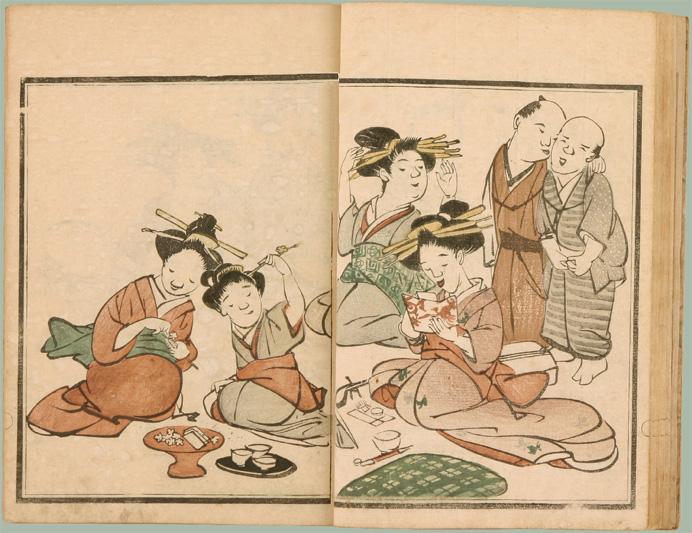Links and write-ups about beautiful things from around the web!
-
Revolver: Looping Animation Shorts
Revolver, a brilliant series of short looping animations by Jonas Odell (codirected with Stig Bergkvist, Marti Ekstrand & Lars Olsson). I loved these when they ran serialized in the early days of Hotwired.com’s Renaissance 2.0 / Kino section, circa 1995, and hastily squirreled away all of the QuickTime .mov’s from the site for archiving. Benefit of having the .mov’s? You could have all of them open and playing simultaneously!
-
Cartoon-y 19th Century Fukuoka Woodblock

I love Edo-era art and cartooning. Hard to imagine doing this with a woodblock! Image found on the always-great BibliOdyssey, also available on Flickr.
-
Have You Forgotten What We Were Like then when We
Have you forgotten what we were like then
when we were still first rate
and the day came fat with an apple in its mouth
it’s no use worrying about Time
but we did have a few tricks up our sleeves
and turned some sharp corners
the whole pasture looked like our meal
we didn’t need speedometers
we could manage cocktails out of ice and water
I wouldn’t want to be faster
or greener than now if you were with me O you
were the best of all my days Animals (1950), from The Collected Poems of Frank O’Hara. -
Vrgb VHS Visual Music Composition n.002
Some glitchy VCR-powered goodness. Via Rhizome.
-
Miles Edgeworth: Turnabout Prosecutor First-Look
(video no longer available)
First localized video from the upcoming Phoenix Wright spinoff, “Miles Edgeworth: Turnabout Prosecutor”. Notable for the series is the move to adventure game-style sprites for the character interaction / investigation scenes. Watching this I realized what must be done: we need a hacked ROM of “Streets of Rage” with these sprites of Edgeworth, Gumshoe, and new “sidekick girl” character Kay replacing Alex, Adam, and Blaze! </videogame nerdery>
-
Db We Used to Say Pirating I Mean the Term
DB: We used to say “pirating.” I mean, the term pirating was used for my early work.
CA: Was it really?
DB: Yeah. For example, when I started, there were no home-recording units. There was no TiVo. There was nothing like that.
CA: I must have been very difficult for you to get that footage.
DB: It was. There was no way to get the footage I needed directly. I had to find people inside the industry who believed in my artwork and were willing to get images out to me. So they called me a “pirateer” of imagery. That had a very romantic sound to it: “Oh, she’s the one who pirated imagery from television.”
Maybe this is the real difference between our generations. In pirating, originally, there was no way to talk back to the media. That’s why I did it. The stuff was coming one way at you, and there was no way to arrest it, stop the action, divert it, alter the vocabulary, or change the syntax.
From Do It 2, a conversation between Dara Birnbaum and Cory Arcangel. Artforum International XLVII, No. 7, p198 -
Certainly Knowledge Comes from Traditional
Certainly, knowledge comes from traditional sources, such as school and books, but it also comes from non-traditional sources like experiences and conversations. Personally, I’m fond of the immersion technique when it comes to learning.
[…]
I think one of the most important things that my career path has taught me is that it is it very important to respect all kinds of art, whether I like it or not. It is not the difference between good or bad art, it is that art comes in different forms and qualities. I like to think of art as a document or reflection of our time. The more able an artist is to make a clear statement, the more lasting it will become. Artists often project ideas on a piece of work, but I think a work’s impact is stronger when a artist can project a broader conceptual belief.
[…]
It takes a second act to understand the first. My interest in art, architecture and music are all constantly informing my work. It is about submerging yourself in something you believe in. I guess the main function of a first act is to flush out ideas – to experiment and refine wheat I think my work should be. A second act allows for self-imposed rules and regulations. It gives me the ability to say no to ideas that are not genuine and complete. I often think of the legendary story of Johnny Cash walking into Sun Studio to record gospel songs. Sam Phillips told him to “go out and sin a little and then come back.” He came back “experienced” and became a legend.
Scott Ingram, Work Ethic. ART LIES no. 61, p65. -
AR Record Scratching
Todd Vanderlin’s working on a project using OpenFrameworks and ARTag markers to simulate scratching a real record but using a camera as a the virtual needle. Nifty.
-
Tom Lehrer: Pollution
One for Earth Day: Tom Lehrer’s Pollution (performed in 1967)
-
UltraEdit UI Horrorshow

UltraEdit, the Windows text editor I’ve been using for years, has a “bold new interface”, cited in the promo email as “a thing of beauty”. Sigh.
